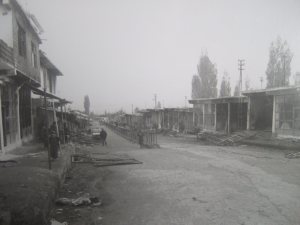“There is Going to Be a Massacre Here Today”: Remembering Lice 20 Years Later
“No protected person may be punished for an offence he or she has not personally committed. Collective penalties and likewise all measures of intimidation or of terrorism are prohibited.
Pillage is prohibited.
Reprisals against protected persons and their property are prohibited.”
– Convention (IV) relative to the Protection of Civilian Persons in Time of War. Geneva, 12 August 1949.
It is still not clear whether security officers of the Turkish state were trying to erase the town of Lice, in central Turkey, from off the map. But the massacre and pillaging they perpetrated in the town this day 20 years ago certainly appeared to be their best efforts towards that aim. What happened in Lice on October 22, 1993 is one of the most egregious examples of Turkey’s human rights abuses against Kurds and it has gone largely unremembered by the international community. But cities hold memories better than nationalist histories do and, 20 years later, stories of what happened in Lice have escaped the confines of official state narratives and betrayed the illusion of liberal Turkish democracy.
What happened in Lice began with the killing of Brigadier General Bahtiyar Aydin. It ended with the destruction of an entire town and the slaughter of at least 15 people and the injuring of at least 22 in revenge.
The government accused the PKK of shooting Aydin in the head on October 22nd early in the morning. Hours later, government forces stormed the town of Lice, destroying properties, attacking people and shooting those who attempted to run away. According to Hevallo, a pro-Kurdish rights campaigner:
A Kurdish conscript of the Turkish army came to the town school and told the teachers to take the children somewhere safe as, “there is going to be a massacre here today”. Then hundreds of soldiers entered the town with jeeps, tanks, helicopters and flamethrowers.
It was collective punishment, in service of a Turkish ethnic nationalism in its worst manifestation. An official government statement placed death casualties at 15. Witness statements and human rights activists estimated it was more than a hundred who perished in the onslaught. Communication in the city was subsequently cut off and journalists, human rights activists and all other non-government personnel were barred from entry into the city.
When journalists were finally able to enter the city, one week later, what they found were the ruins of a city razed to the ground. Over 400 homes and 250 shops were burned down. The buildings that remained were riddled with bullet homes. Cars and buses were burnt out. The city is abandoned.
Halil Nebiler, one of the journalists who was allowed into the city on october 29th, wrote an account of his observations for the newspaper, “Cumhuriyet”, a copy of which is available courtesy of Hevallo. His eery descriptions of the city capture the fearful aftermath of what appeared to be an attempt to ethnically cleanse the town of its Kurdish inhabitants. He wrote:
“The mosque is full of holes, too. On the minaret, there is a hole as big as a human head, on a point which is one and half meters high from the ground.
…The picture of the burnt and destroyed downtown is still in front of my eyes. There is something that has leaked out of a shop towards the road and has been frozen, which makes me think that it is a gutter formed by melted down plastic materials in the shop.”
Twenty years later, the Turkish government continues to deny any involvement in the massacre — in fact, they blamed the killings on the PKK. Recently, however, a new investigation into the “suspicious” killing of Bahtiyar Aydin calls into question the circumstances of his death. Prosecutors allege that JİTEM, a controversial counter-terrorism unit of the Turkish Armed Forces, was actually responsible for Aydin’s death. JİTEM has been implicated in many extrajudicial kidnappings, torture and killings of PKK members and other Kurdish political activists. It would appear, from these recent allegations, that JİTEM killed Aydin in an attempt to justify the subsequent massacre in Lice.
Justice, however, will not be done until the Turkish government recognizes its role in the in the Lice massacre. Human Rights Watch concluded earlier this year that Turkey has made no real effort to investigate the injustice committed against the Kurdish people during the 90s and prosecute those responsible despite efforts from Kurdish villages that took their cases to the European Court because they could not obtain justice in Turkish courts.
Emma Sinclair-Webb, senior Turkey researcher at Human Rights Watch, said:
Justice for the crimes of the 1990s is an important element among the human rights steps to resolve the Kurdish issue.
Ending decades of impunity for security forces and other public officials for the serious human rights violations perpetrated in the 1990s will take a real commitment from the government and prosecutors.

Comments are closed.